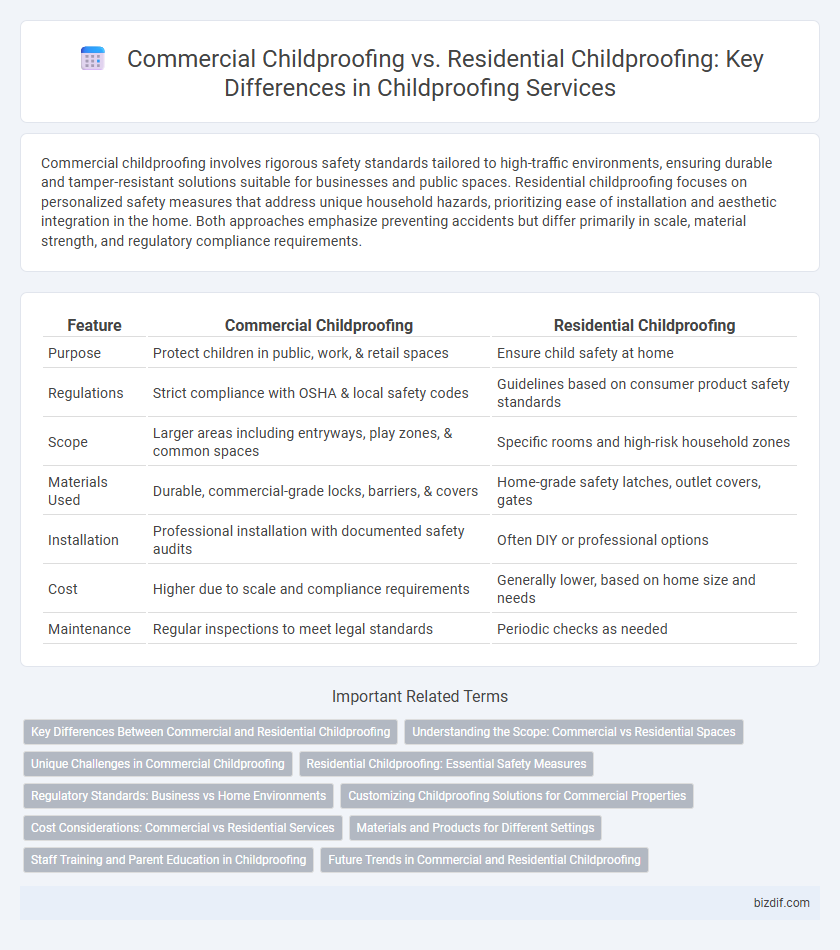Commercial childproofing involves rigorous safety standards tailored to high-traffic environments, ensuring durable and tamper-resistant solutions suitable for businesses and public spaces. Residential childproofing focuses on personalized safety measures that address unique household hazards, prioritizing ease of installation and aesthetic integration in the home. Both approaches emphasize preventing accidents but differ primarily in scale, material strength, and regulatory compliance requirements.
Table of Comparison
| Feature | Commercial Childproofing | Residential Childproofing |
|---|---|---|
| Purpose | Protect children in public, work, & retail spaces | Ensure child safety at home |
| Regulations | Strict compliance with OSHA & local safety codes | Guidelines based on consumer product safety standards |
| Scope | Larger areas including entryways, play zones, & common spaces | Specific rooms and high-risk household zones |
| Materials Used | Durable, commercial-grade locks, barriers, & covers | Home-grade safety latches, outlet covers, gates |
| Installation | Professional installation with documented safety audits | Often DIY or professional options |
| Cost | Higher due to scale and compliance requirements | Generally lower, based on home size and needs |
| Maintenance | Regular inspections to meet legal standards | Periodic checks as needed |
Key Differences Between Commercial and Residential Childproofing
Commercial childproofing involves adhering to strict regulatory standards and safety codes tailored for public spaces, ensuring compliance with legal requirements such as ADA and fire safety regulations. Residential childproofing focuses on customizing protections to a family's specific needs, targeting common household hazards like sharp edges, electrical outlets, and toxic substances. Key differences lie in the scale, regulatory oversight, and the variety of safety hazards addressed in commercial environments versus private homes.
Understanding the Scope: Commercial vs Residential Spaces
Commercial childproofing involves securing larger, high-traffic areas such as schools, daycare centers, and healthcare facilities, requiring compliance with strict safety regulations and accommodating diverse age groups simultaneously. Residential childproofing focuses on personalized safety solutions within homes, targeting specific hazards like sharp furniture edges, electrical outlets, and staircases to create a secure environment for infants and toddlers. Understanding the scope differences is crucial for selecting appropriate safety measures that address unique risks and regulatory requirements in commercial versus residential settings.
Unique Challenges in Commercial Childproofing
Commercial childproofing requires addressing higher foot traffic and diverse user interactions, demanding robust, industrial-grade safety solutions unlike residential settings. Unique challenges include compliance with stringent safety regulations, integration with business operations, and ensuring durability under frequent use. Effective commercial childproofing also involves tailored risk assessments to protect various age groups while maintaining accessibility and aesthetics in public spaces.
Residential Childproofing: Essential Safety Measures
Residential childproofing involves installing safety gates, outlet covers, and cabinet locks to create a secure home environment for children. Tailored measures address common household hazards, such as securing furniture to prevent tipping and using window guards to avoid falls. These essential safety solutions reduce the risk of injury and offer peace of mind in everyday living spaces.
Regulatory Standards: Business vs Home Environments
Commercial childproofing adheres to stringent regulatory standards set by OSHA and local fire codes to ensure safety in business environments, focusing on high-traffic areas and public liability compliance. Residential childproofing follows guidelines from organizations like the Consumer Product Safety Commission (CPSC), emphasizing hazard prevention tailored to private living spaces and typical household risks. Businesses require more robust safety installations such as exit signage and fire-resistant materials, while homes prioritize securing furniture, electrical outlets, and toxins to create a safe environment for children.
Customizing Childproofing Solutions for Commercial Properties
Commercial childproofing requires tailored safety solutions to address higher foot traffic and diverse hazards compared to residential settings. Customizing childproofing for commercial properties involves installing durable, code-compliant safety gates, corner guards, and secure locks that withstand frequent use. Integrating comprehensive risk assessments ensures all areas, including play zones and waiting rooms, meet stringent safety standards for children.
Cost Considerations: Commercial vs Residential Services
Commercial childproofing services typically incur higher costs than residential childproofing due to larger spaces, increased safety regulations, and the need for specialized equipment. Residential childproofing expenses are generally lower, reflecting smaller areas and fewer compliance requirements. Budgeting for commercial projects often includes ongoing maintenance and liability insurance, which are less common in residential settings.
Materials and Products for Different Settings
Commercial childproofing requires industrial-grade materials such as heavy-duty corner guards, reinforced gate barriers, and tamper-resistant outlet covers designed to withstand high traffic and strict safety regulations. Residential childproofing often utilizes softer, aesthetically pleasing products like foam edge protectors, decorative plug covers, and adjustable cabinet locks tailored for home environments. Selecting materials suited to each setting ensures compliance with safety standards and maximizes child protection effectiveness.
Staff Training and Parent Education in Childproofing
Commercial childproofing requires specialized staff training focused on compliance with industry safety standards and handling higher-risk environments such as schools and daycare centers. Residential childproofing emphasizes parent education to empower caregivers with practical safety techniques for everyday home hazards. Both approaches prioritize proactive risk management but tailor training and educational resources to their unique settings.
Future Trends in Commercial and Residential Childproofing
Emerging trends in commercial and residential childproofing emphasize smart technology integration, such as IoT-enabled safety devices that allow real-time monitoring and hazard alerts. Both sectors are adopting eco-friendly, non-toxic materials to enhance safety while supporting sustainability goals. Future innovations are expected to focus on customizable, adaptive solutions that address specific environmental and regulatory requirements unique to commercial and residential settings.
Commercial childproofing vs Residential childproofing Infographic

 bizdif.com
bizdif.com